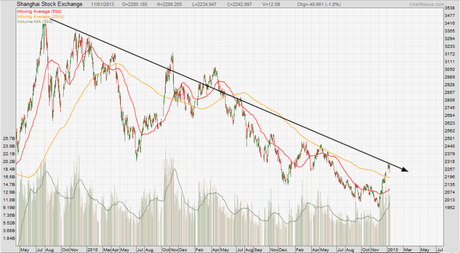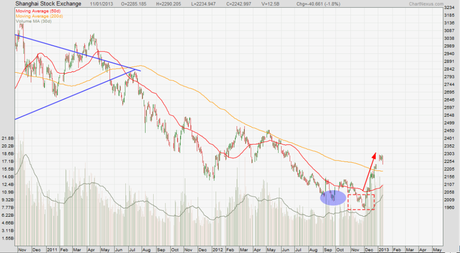Evening all,
Equity markets are off to a good start to the new year. The general mood is more positive now, with most investors believing the Europe crisis is slowly dissipating, and the feared fiscal cliff disappearing from the face of financial media – though some will say the timer for these ticking time bombs were reset. Sometimes I do not know what to believe – whether a catalyst for underlying problems will emerge and shatter markets or another leg in the multi-year bull run that markets are in. But if you are a regular reader, you know what my bias is.
Outside of the western world, we have the huge chinese economy, which is still considered “emerging”, that provides us with a kind of wild card. Along with global indices, the Shanghai Stock Exchange (SSE) experienced a sharp rally in the last few weeks. If you need to visualise how the SSE’s chart looks like prior to the recent rally, think of a white space, and a bold, red arrow (or if you are from China, green) pointing diagonally downwards like the hour hand when a clock reads 4 o’clock. This recent rally in SSE caught me totally off guard. Has the chinese market finally made a bottom?
To put things into perspective, look at the chart below. Ever since the top in 2009, the SSE has been in a long-term downtrend. Volatility is present for sure, but you can make out a clear, long-term trend channel. So, the recent rally looks like a healthy short-term correction.

For long-term set-ups, the downtrend is more or less intact still. The recent run-up shuld be seen as a good window of opportunity to sell into. I am not buying into the recovery camp but I am sure the SSE will have more room for upside especially if the buying pressure continues into February. For longer-term outlooks, I want to see some sort of consolidation or pattern that signifies a bottoming phase. Only then can I be sure, as a chartist, that a market is turning. For now, I am still bearish on SSE.
If you refer to my past posts on the SSE, you will see that I sounded the bearish bells because of a straightforward breakout towards the downside from a triangle pattern – the triangle was very large. http://technicalanalysistalk.wordpress.com/2011/09/10/sse-broken-down-from-triangle/
I get skeptical of my own analysis when I encounter enormous patterns. Are they really going to work? In my experience, some do, some do not - much the same as “regular”, smaller patterns. Anyways, I traded the SSE accordingly. I will not go into the specifics of my trades in products acting as proxies to the SSE, but I admit that I was stopped out at least once. In retrospect, I did not plan out my trades as well as I should have. Yes, stops were in – I already learn my lesson years ago – but could they have been wider to allow for more volatility that matches the duration of the trade I made (planned time horizon)? This is yet another case where the analysis turns out right but weak money management skills and trading strategy (or an insufficient amount) causes the trader to lose money.
At thas point, I can tell myself not to trade with stops – but I know better than to come to that conclusion. Two loss-making trades in the Shanghai Stock Exchange (CFD instruments) gave me some lessons on stop placement and trade selection. However, something happened to the price action of the SSE that reinforced my faith in money management.
Sometime in the last two months of 2012, I was feeling sore from getting stopped out in my trades in the SSE. How do you lose money shorting the SSE in 2012? (More an exclamation than a question). I was itchy for a “long-term, straightforward short in a weak market”. After watching the market for a few days, I set out the trading parameters and got a short in. To my surprise, the SSE got on a launchpad and flew skywards. My stop – placed in a position I put much thought in was hit. The SSE continued to rally to where it is now. This time round, I had no sore feelings. I was better prepared with the short, and knew what kind of trade I was making. As I look at where the SSE is trading now, I can only feel happy that my loss with taken early. I made other CFD trades throughout the same period, and good money management skills meant my profitable trades far exceeded the losses I made on the SSE.

All analyses, recommendations, discussions and other information herein are published for general information. Readers should not rely solely on the information published on this blog and should seek independent financial advice prior to making any investment decision. The publisher accepts no liability for any loss whatsoever arising from any use of the information published herein.
